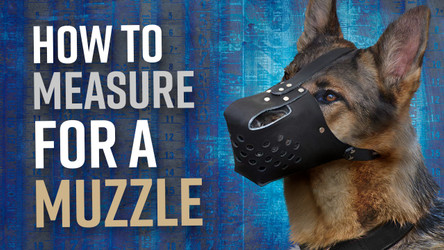How to Measure for Dog Muzzle Sizing
Mar 6th 2024
Measuring your dog for a muzzle is pivotal, ensuring their safety and comfort across various scenarios, from training to routine vet visits. This detailed guide aims to simplify the process, equipping you with the knowledge to secure a muzzle that guarantees an ideal fit. Achieving the correct muzzle fit is more than a comfort issue; it's about ensuring your dog can still pant, drink, and breathe without hindrance, enhancing their well-being during use.
Understanding the Importance of a Proper Fit
A well-fitting muzzle maintains proximity to the dog's nose without causing discomfort, ensuring no impediment to essential activities like breathing, panting, or drinking. This balance is critical; a snug fit keeps the muzzle in place, yet it must allow the dog full mouth mobility. Recognizing the right fit is akin to selecting precision gear for operational efficiency, it should optimize performance, not limit it. Ensuring this fit enhances your dog's acceptance of the muzzle, fostering a positive association and comfort.
Step-by-Step Guide for Dog Muzzle Fitting
- Nose to Skull Measurement
Place one end of a soft measuring tape at the tip of your dog's nose and extend it to the top of the ears or the base of the skull. This measurement ensures the muzzle length is adequate, preventing any pressure on the dog's eyes or nose. - Neck Circumference
Measure around the neck, where a collar would typically sit. This measurement is similar to fitting a dominant dog collar, high and somewhat tight but comfortable. - Mouth Opening and Closure
Measure the circumference of your dog’s mouth when it is open at its widest and when it is closed. Start from the bridge of the nose and wrap the tape around the mouth. This ensures the muzzle allows for natural mouth movements. - Nose to Base of the Eyes
This measurement is critical for ensuring the muzzle's correct positioning. Measure from the tip of the nose to the base of the eyes. This distance helps prevent the muzzle from obstructing the dog's vision or interfering with the eyes. - Bottom of the Jaw to the Neck
The final measurement is from the bottom of the jaw to the neck, determining where the muzzle's strap will be positioned. It's important to note that this is not measured to the back of the head but around the lower part of the jaw to where the neck strap will sit.
Tips for a Smooth Measuring Process
Stay Calm: Keep the measuring process calm and positive. Use treats and praise to make it a pleasant experience for your dog.
Be Precise: Accuracy is key. It's better to be precise with your measurements to ensure a comfortable fit.
Consult a Guide: Many manufacturers provide sizing guides. You can consult our Muzzle Comparison Chart for both general and Ray Allen specific muzzles. Compare your measurements against these guides to find the best fit.
Choosing the Right Muzzle
Selecting the perfect muzzle for your dog is crucial for their comfort and safety. The aim is to find a balance between a secure fit and allowing your dog natural mouth movements. Consider the material, soft fabric, leather, wire, or durable plastic, based on your dog’s needs and the muzzle's purpose. Adjustable features are a plus for a perfect fit. Measuring accurately ensures you pick the right size, avoiding the inconvenience of returns. Gradually introducing the muzzle to your dog with positive reinforcement will help them adjust comfortably.
Measuring your dog for a muzzle is a vital step towards their well-being. This guide simplifies the process, ensuring a comfortable and safe fit. A well-fitted muzzle makes a significant difference in your dog's acceptance and ease with it. With careful selection and patience, you'll find a muzzle that suits your dog perfectly, enhancing both safety and comfort.
Don't forget to check out our handy muzzle sizing chart quick-reference. Then shop our large selection of dog muzzles.





